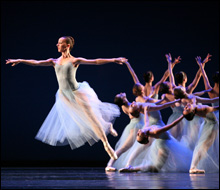
SERENADE: Melanie Atkins goes in many directions, all of them right.
|
Dance is all about direction. The kind that’s most palpable is what you see on the dancers’ bodies: high-flying leaps, six o’clock penchées, 90-degree tours à la seconde, turns that hurtle everybody off stage. But a dancework also has its direction: some whip you from side to side, some rise into the stratosphere, some stomp on the ground. Created just a dozen years apart, Bronislava Nijinska’s Les Noces and George Balanchine’s Serenade are polar opposites. Les Noces, with its Igor Stravinsky score, is all earth, a ceremony/cycle of copulation and reproduction, birth and death, as brown as its village women’s jumper dresses. Serenade, to Tchaikovsky’s Serenade for Strings, is all air, its romantic attachments evanescent, its ambiance as filmy blue as its tulle skirts. These touchstones of 20th-century dance anchored Boston Ballet’s final two presentations of the 2006–2007 season, Les Noces on an “Evening of Russian Ballet” program with the “classic” section of the third act of Raymonda and a quintet of party pieces, Serenade coupled with the world premiere of Finnish choreographer Jorma Elo’s Carmen for a program that will continue at the Wang Theatre through this Sunday.
Le Sacre du Printemps aside, dance hadn’t seen anything like Les Noces before 1923 and hasn’t seen much like it since. The pounding score, for vocal soloists, a chorus, four pianos, and percussion, is ritual as rhythm; the folk-like texts are nuptials as nursery rhyme. Bride and groom are from different villages and are meeting for the first time. In the first tableau, the Bride and her Bridesmaids sing of her long braided tresses, symbol of her virginity, which she’s about to sacrifice as she leaves the security of childhood. The text, in any language (here it’s sung in English), is scarcely intelligible, but the twin 11-foot-long braids of Nijinska’s staging make the point visual; it’s a wonder the Bridesmaids don’t use them for jump ropes. It’s all hair on the Bridegroom’s side as well, the Virgin Mary being implored to come and comb his fair locks. The good wishes of the chorus representing both villages mitigate the uncertainty of the couple’s new life, but you don’t hear that in the music, and you don’t see it on stage. Nijinska fractionates her dancers as if she were Picasso in his Cubist period, and they move like marionettes, subject to a higher, or a chthonic, power.

Karine Seneca’s Bride caught both Stravinsky’s depersonalization and Nijinska’s displacement, particularly in the first-tableau section where, crouching in profile, the Bride has to raise and lower herself like an elevator — Seneca hit every floor, with no stops in between. Tai Jimenez was a softer, almost Appalachian Spring–like Bride, registering a degree of apprehension and hope, her elevator sliding a bit in what could be seen as a less appropriate interpretation or just an alternative one. They were matched by their Bridegrooms, Roman Rykine for Seneca, Pavel Gurevich for Jimenez. In the final tableau, the wedding feast, his best friend and her best friend — likely the next to be married off — have brief solos; Mindaugas Bauzys, who’s from Lithuania, not far from where Stravinsky was born, strutted his quirky, folky stuff as if the music had been written for him. The corps did Nijinska’s ethos, which is anything but balletic, full justice. The men and women for the most part occupy opposite sides of the stage, as they would in church. It was perhaps some comfort to the Bride and Groom to think that come the next wedding they’d be reintegrated into the community.
Looking much as it must have in 1923, Les Noces seems flash-frozen — it’s too primal to undergo evolution. Serenade, on the other hand, has emerged from a long and difficult gestation. Balanchine set it on his School of American Ballet in 1934, to the first three movements — Pezzo in forma di sonatina, Valse, Elegia — of Tchaikovsky’s score, using whatever dancers showed up for each day’s rehearsal. He didn’t add the “Tema russo” Finale until 1940, and then he inserted it as the third section of the ballet, whose four movements are called Sonatina, Waltz, Tema Russo, and Elegy. The original Serenade had no solo parts; Karinska’s blue-white tulle skirts didn’t arrive till 1952; and it wasn’t till 1977 that the three female principals — the Waltz Girl, the Russian Girl, and the Elegy Angel — let down their hair in the Elegy, much to Arlene Croce’s displeasure.
There’s an initial conventional story — boy meets girl before a sisterhood backdrop of 17 women, with two additional solo women for decoration — but that indelible opening, the 17 women all with right arm outstretched and right hand flexed, is a warning shot across its bow. When the other women stride off at the end of the Sonatina and the Waltz Boy strides on, threading their ranks in counterpoint, to dance with the Waltz Girl, you’re meant to wonder whether counterpoint equals counterweight. The flowering trellis of five bourréeing women with arms elevated and interlocked at the beginning of the exuberant, folk-like Tema Russo raises further doubts, so it’s not a shock when, as the ensemble dash off in triumphant exultation, the Waltz Girl crashes to the floor.